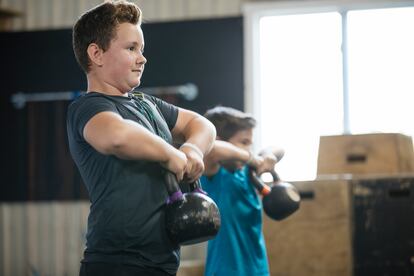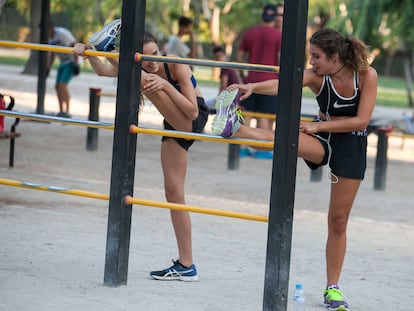Strength training for children: The myths, facts and benefits
While parents may be hesitant to involve their kids in weightlifting, studies show these activities can improve motor skills and reduce the risk of injury

Álvaro, 22, recounts how he began training when he was 11 years old. “They told me that I would stay small, that my muscles would not allow me to grow, but my parents listened more to science than to the rumors,” says Álvaro, who now measures 1.84 meters.
For many years, it was believed that the strength gained by training would damage children’s immature skeleton and lead to injury by inhibiting bone growth. The idea of children practicing weightlifting has been largely frowned upon. But although children can injure themselves in weightlifting and other related activities, studies show the rate of injury is relatively low. According to recently published scientific data, properly planned and supervised strength training programs can improve athletic performance, reduce possible injuries and improve health.
Parents are often wary when it comes to strength training for children, but these fears are largely based on myths. We use strength in all actions in our everyday life, as do kids. Children carry backpacks, climb the stairs and go for walks — actions that are carried out thanks to the neuromuscular system, in other words, thanks to strength. But when it comes to strength training for children, there are some issues that should be taken into account.
A child is not a small adult
A child should not follow the same exercise guidelines or programs as an adult. Children love games. Strength-building exercises include kicking a ball, climbing, jumping. For resistance, they can use their own body weight, as well as a whole range of equipment, including elastic bands, water bottles, balls, ropes, weights, dumbbells and even the swings.
In its latest manual, the National Strength Conditioning Association (NSCA) states that it is important to encourage pre-teens to practice 60 minutes or more of moderate or vigorous physical activity as part of outdoor games, active transportation, and school activities.
The playground: the perfect place to play and train
Have you stopped to watch children in a playground or in a park? They run, crawl, climb, run up and down slides, jump on benches, push swings. All of this implies strength work.
They also play “cops and robbers,” which involves short bouts of high-intensity exercise. This supports the idea that children’s natural activity pattern is characterized by sporadic bouts of moderate to intense activity, with brief periods of low-intensity activity or rest as needed. As the NSCA explains, it’s wrong to assume that children are inactive just because they don’t engage in continuous physical activity. The interval method (which is used in games such as tag) might be best suited for training youngters, because most children do not enjoy prolonged periods of continuous aerobic endurance activity, such as running around the yard for 30 minutes non-stop.
What’s more, cardiorespiratory adaptations, such as increased aerobic capacity, may be less noticeable in children compared to older adults, as suggested by recent research in the journal Sports Medicine. High-intensity interval training (HIIT) is closer to children’s usual pattern of activity, which means it could be a time-efficient way to improve their cardiometabolic health.
The benefits
The benefits of strength training, as outlined by a study in the American Journal of Lifestyle Medicine, range from direct physiological changes such as increased muscle strength, bone density and improved cardiovascular function, to indirect changes in mobility, pain reduction, injury prevention and self-esteem.
- Increase in strength. The relative gains observed in girls may be greater than in boys because baseline neuromuscular performance levels are lower on average, but girls have been shown to improve measures of strength up to 92% with just six weeks of training.
- Improves motor skills. Strength training gives youngsters better control of their body. Training programs, which also include plyometrics (education on jumping and landing techniques), postural balance and body position (proprioception), improve the biomechanics of movement and strength of the lower extremities.
- More bone mineral density. Weight training promotes bone formation.
- Benefits body composition, lipid profile and insulin sensitivity. This helps prevent excess weight, obesity and their associated pathologies.
- Reduced risk of injury. Based on current findings, pediatric strength training has a low risk of injury in children following age-appropriate guidelines.
- Encourages a more positive attitude towards physical activity. Good health habits established during childhood can be carried into adulthood. Well-organized training sessions that give children the opportunity to experience the fun of exercise can have lasting effects on their health and well-being. The objective of physical preparation programs for young people should be not only to get them to participate in activities and games appropriate for their age, but also to make them aware of the benefits and intrinsic value of exercise, so that they stay physically active as adults.
It’s important to remember that children should not undertake strength training on their own, or without the guidance of a qualified professional, since using the equipment or weights could cause an injury if it is done improperly.
From the theory to the practice
Here are some training guidelines from the NSCA:
• Supervision and directions must be provided by qualified adults.
• The training environment must be safe and free of hazards.
• Strength training should be preceded by a dynamic warm-up of five to 10 minutes.
• Start with one or two series of eight to 12 repetitions of varied exercises.
• Include exercises for the upper body, lower body, and core.
• Increase weight gradually (for example, by 5-10%) as proficiency in strength training skills improves.
• Do strength training two or three days per week, but not on consecutive days.
• Children should do a cool down with less intense calisthenics and static stretching.
• Vary the strength training program over time to optimize strength gain and prevent boredom.
Sign up for our weekly newsletter to get more English-language news coverage from EL PAÍS USA Edition
Tu suscripción se está usando en otro dispositivo
¿Quieres añadir otro usuario a tu suscripción?
Si continúas leyendo en este dispositivo, no se podrá leer en el otro.
FlechaTu suscripción se está usando en otro dispositivo y solo puedes acceder a EL PAÍS desde un dispositivo a la vez.
Si quieres compartir tu cuenta, cambia tu suscripción a la modalidad Premium, así podrás añadir otro usuario. Cada uno accederá con su propia cuenta de email, lo que os permitirá personalizar vuestra experiencia en EL PAÍS.
¿Tienes una suscripción de empresa? Accede aquí para contratar más cuentas.
En el caso de no saber quién está usando tu cuenta, te recomendamos cambiar tu contraseña aquí.
Si decides continuar compartiendo tu cuenta, este mensaje se mostrará en tu dispositivo y en el de la otra persona que está usando tu cuenta de forma indefinida, afectando a tu experiencia de lectura. Puedes consultar aquí los términos y condiciones de la suscripción digital.
More information
Últimas noticias
Most viewed
- Alain Aspect, Nobel laureate in physics: ‘Einstein was so smart that he would have had to recognize quantum entanglement’
- Alvin Hellerstein, a 92-year-old judge appointed by Bill Clinton, to preside over Maduro’s trial in New York
- Gilles Lipovetsky: ‘If you want to live better and fall in love, take Prozac, don’t look to philosophy’
- Cuba confirms death of 32 of its citizens in the US attack against Venezuela
- Why oil has been at the center of Venezuela-US conflicts for decades










































